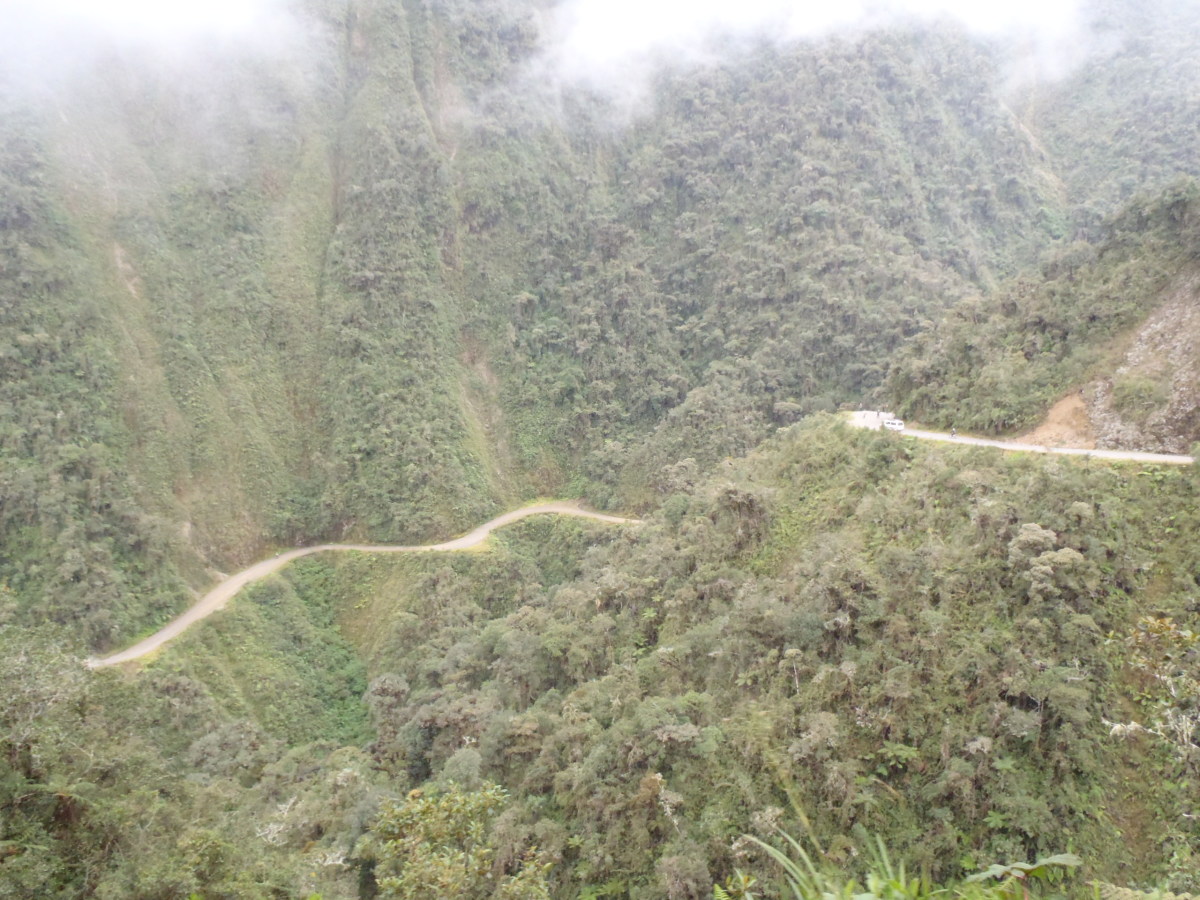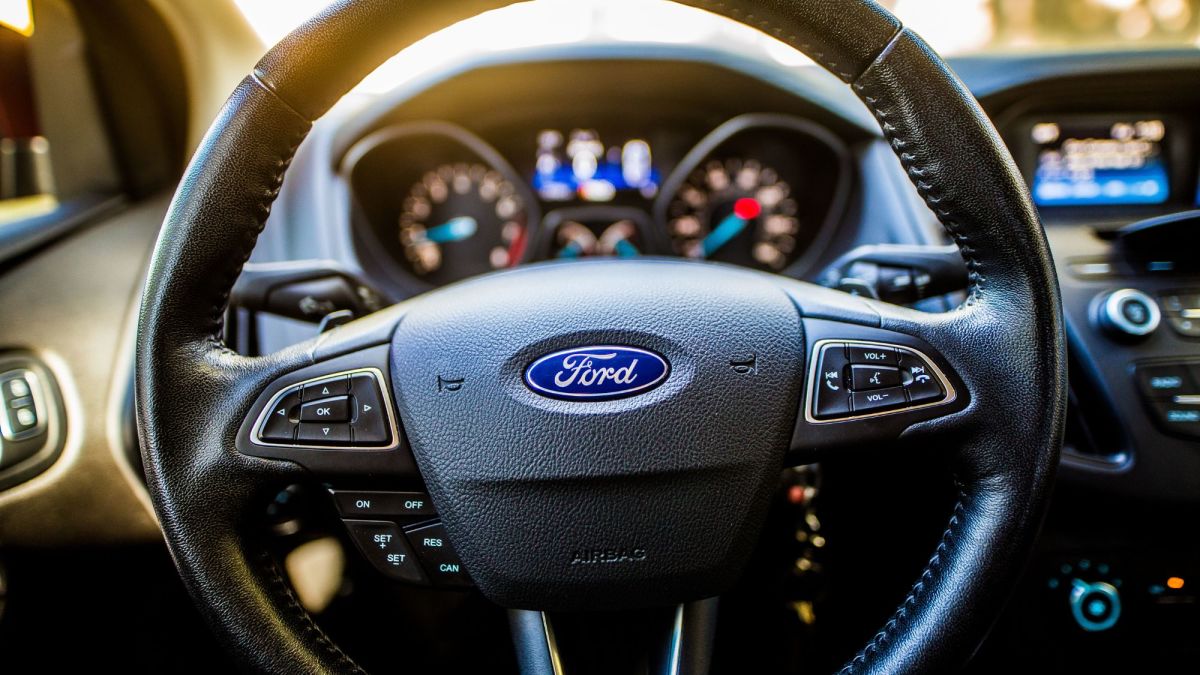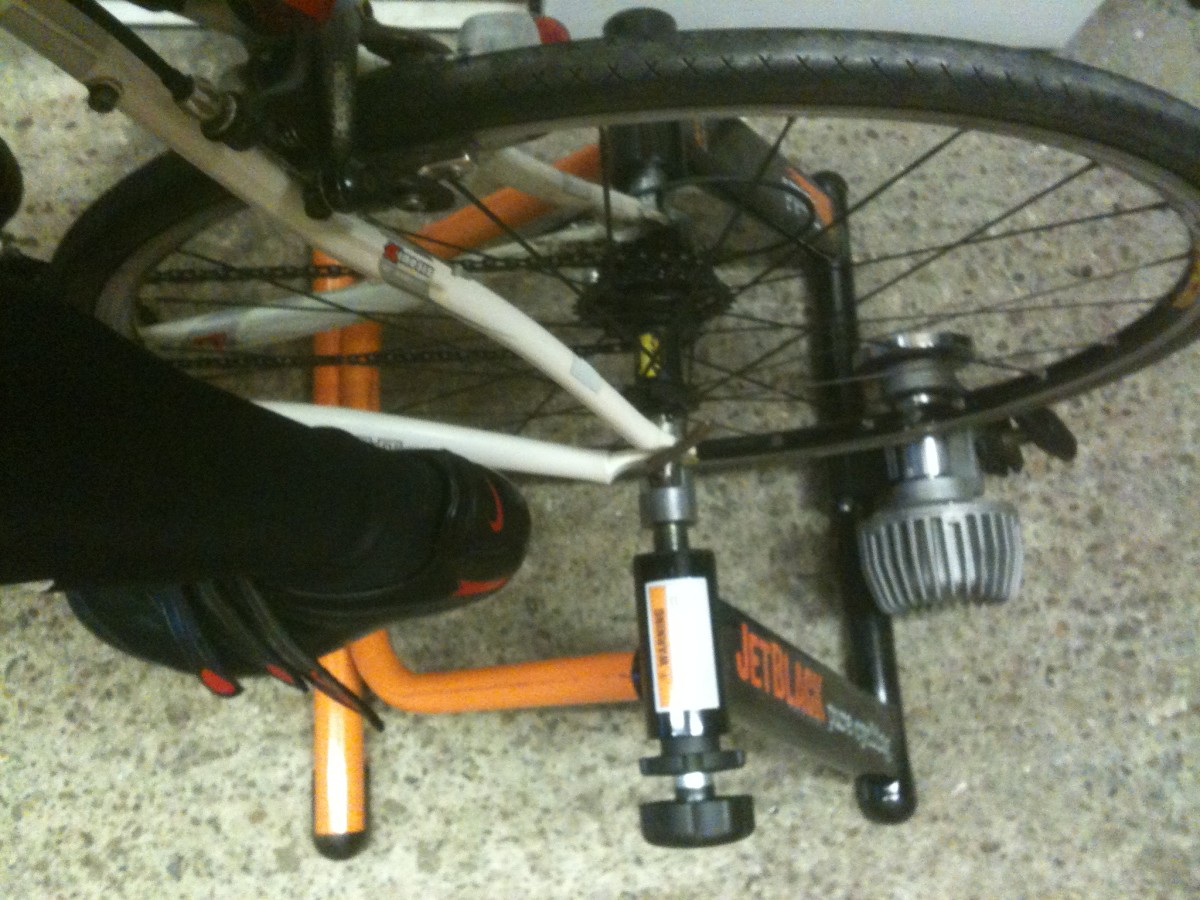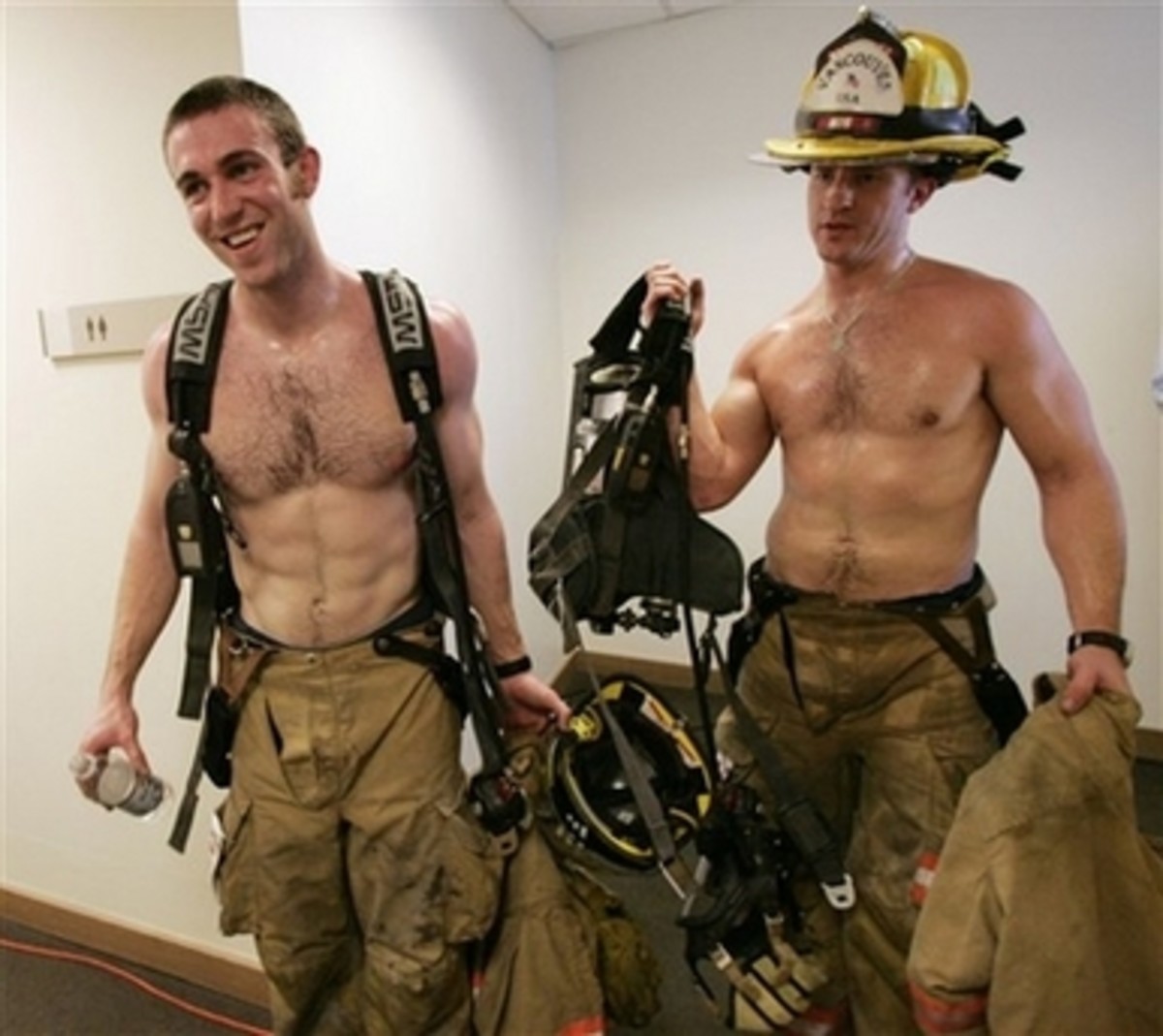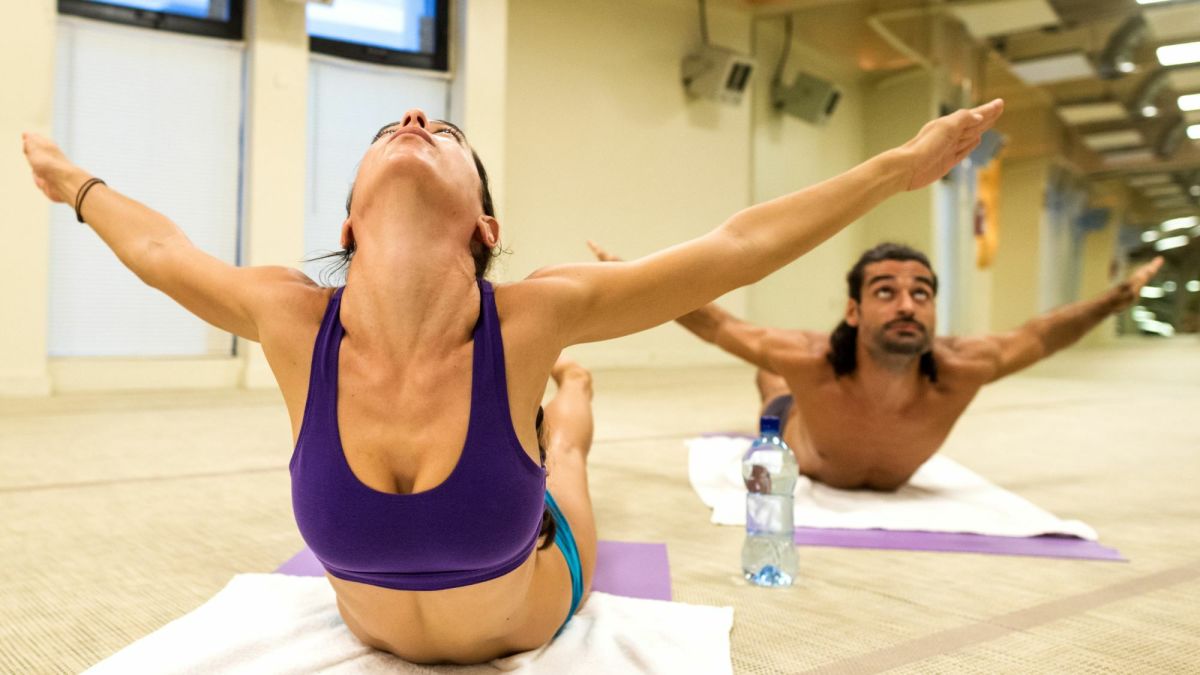Descending 101- The Very Essence Of Descending On A Bicycle!
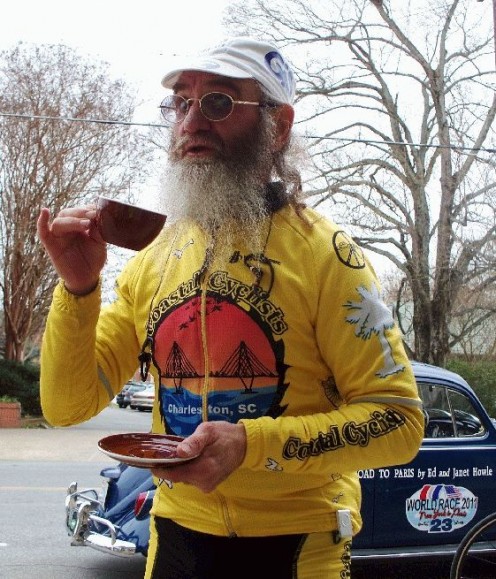
This information is not to encourage you to ride faster.
The tips are provided for safety - not speed.
At any speed these often excluded tips are very important.
The information on this page is the most important information on descending steep, fast, and technical descents while riding a "road" bike.
I have read articles of descending. I’ve painfully watched videos of descending by authorities the cycling community trusts.
Lives are at stake, really. I feel that it is imperative that my words be heeded.
And – the true essence of descending has not been written or spoken to my knowledge. Perhaps I’ve not searched far enough. But, I have not seen my words of this “essence” on the internet or in any documentation whatsoever.
There is more information available that is valuable.
Most is secondary to what you will read here.
Please do a search and find as much information possible for safety.
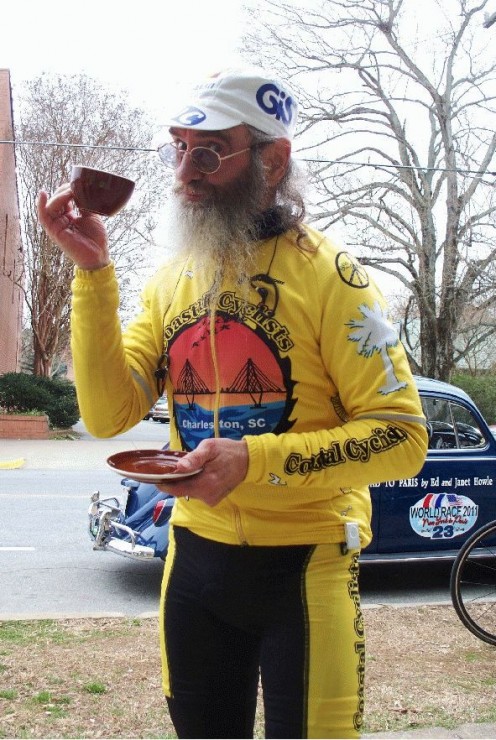
"A" Universal Rule!
Never, ever do anything you don’t feel good about!
This is great advice on and off the bike.
You cannot exceed your speed limit. You cannot “take a chance”. When you begin to enter the realm of “not knowing”, guessing, hoping, and fearing- you’re beginning to fail.
Another "GIVEN" rule of descending and cornering is:
In a curve- ALWAYS have the outside pedal down and the inside pedal up!
Do not put a pedal down to the inside in a curve!
Do not put a pedal down on the side on which you are leaning.
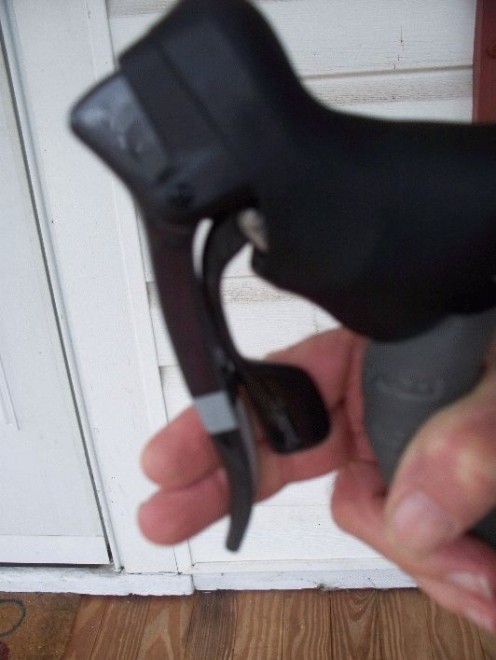
The “essence” of descending is:
Firstly- assuming your brakes and brake pads are in working order, adjust your brakes so that-
when you are in the “hooks” of the road-racing-riding handle-bar, you should be able to wrap your index finger and the next finger on the brake lever with the top joint on the front of the lever.
For a large hand, this may not have much relevance.
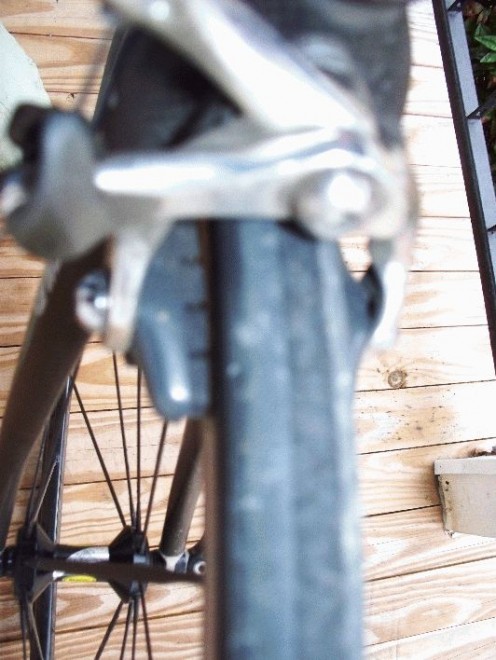
For small hands or short fingers, this is life and death, quite literally.
Adjust those brakes so that when your fingers are in that position, the brake pads are very close to the rim but not touching.
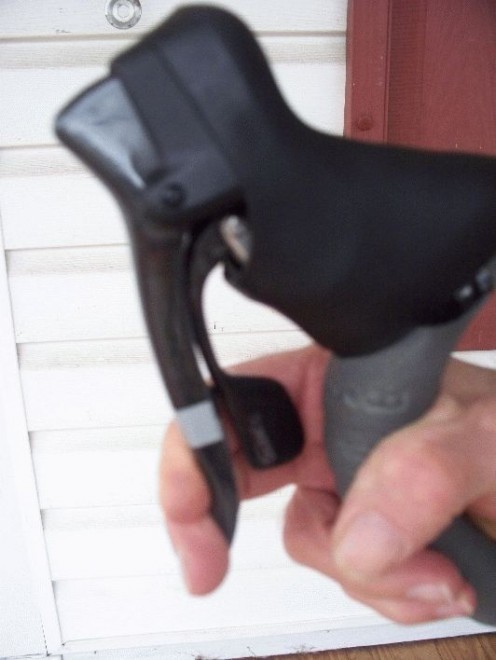
This is the relaxed and FUNCTIONAL position.
I would suggest that short fingered people "Do not allow your brakes to be adjusted fully tight."
A small hand would have to reach out to pull the lever inward. That would not be control.
Some will instruct riders to use only the rear brake. Well, I’m sorry, but there are some places where you might use not, only the two brakes that your bike is equipped with, but also the bottoms of your shoes.
For safety, "stay in the “hooks”!
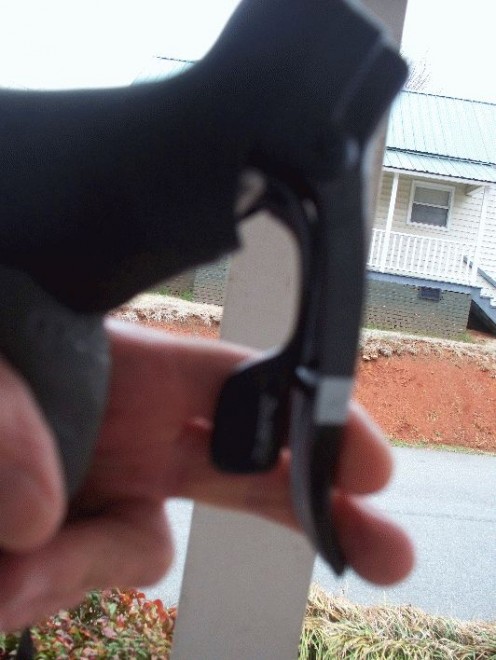
Pull both brake levers in so that the crooks of the fingers are as described. Apply both brakes but usually more with the rear.
When you need to slow your bike down- you need to be very fluent in both of the brakes.
Some instructors will say that you should brake before the turn and not during. Nope. You are in the hooks. The top joints of the two long fingers are on the lever and the levers are drawn toward the rim or maybe slightly slowing the rims down. This continued “hold” on your equipment with proper posture will give you the best chance for safe riding.
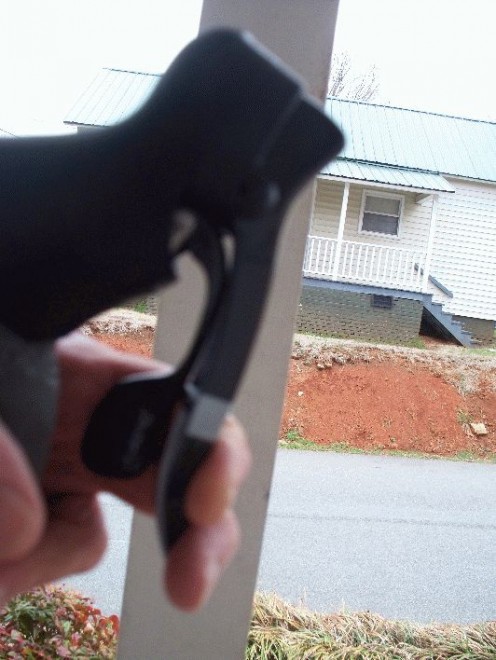
The front brake is the most powerful.
Your weight actually works more in your favor to stop. This I learned at Ed Salley’s motorcycle shop.
One reason that avoiding the front brake is suggested in some situations is the possibility of doing an “endo” and going over the handle-bars. And- thus, the need for sliding your rear to the rear.
It is very possible to lock that front wheel up and doing so will take your steering.
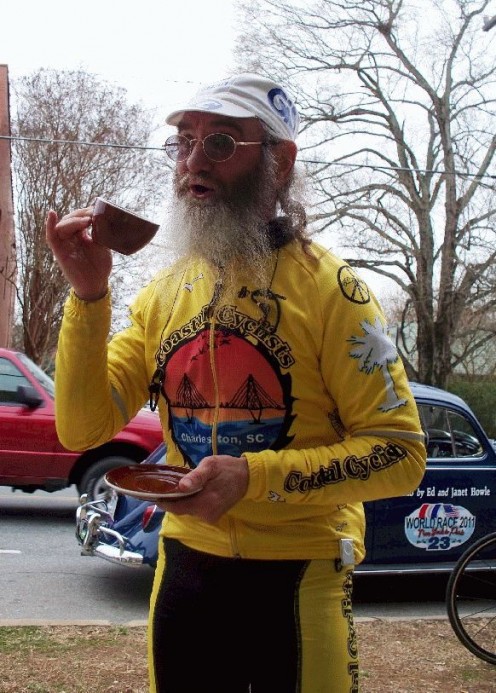
Another reason to use the front brake very carefully or to avoid the front brake, particularly, is that you lose steering.
As long as the front wheel is turning, you have some steering. If you lock either wheel, you can skid out of control.
Example: Thanksgiving decades ago, a few of us were descending down from Craggy Gardens near Asheville. The Blue Ridge Parkway is often closed for repairs or weather. This happens a lot in the winter. We had gone around a closed barrier as runners and cyclists often do. We climbed to Craggy and were heading home. We weren’t expecting anything on the road. We had the road to ourselves. We were riding three across. I was in the middle. We had an okay speed, maybe around 40. The Parkway isn’t over 9% anywhere. A motorcyclist had done what we did and was turning into the Craggy picnic area which is several miles down from Craggy. The problem is – he stopped on the center line! One rider went to the left. One rider went to the right. I was locking the brakes up heading straight for the motorcycle. I could feel some ribs breaking in my immediate future. Right at the perfect moment – I let that front brake go and went to the left of the motorcycle. A clean pair of shorts and all was good.
But- the bottom line, real deal here was –
I needed my front and my rear brake
and I needed to let them go.
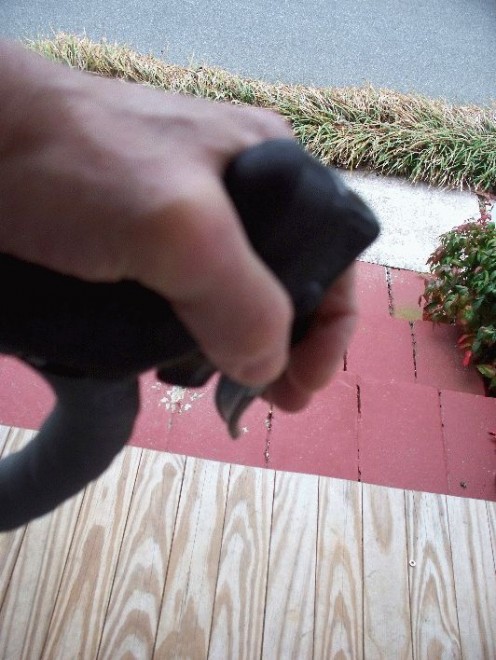
For the safest body position for descending technical curves– put your hands in those “hooks”, not on top of the levers and lever hoods.
Many riders can do many things so well with their hands on top of the levers and lever hoods. Many people ride in groups and race criteriums (races usually “downtown” around city blocks) with their hands on top instead of in the “hooks”. I surely cannot teach this as the safest position for the hands.
Come to terms with "feathering your brakes".
You'd like to be smooth.
Sporadic riding can always be negative, for you or the rider behind you.
You would rather "brake steadily".
When your original plan falls apart, you might better try braking and making an exit.
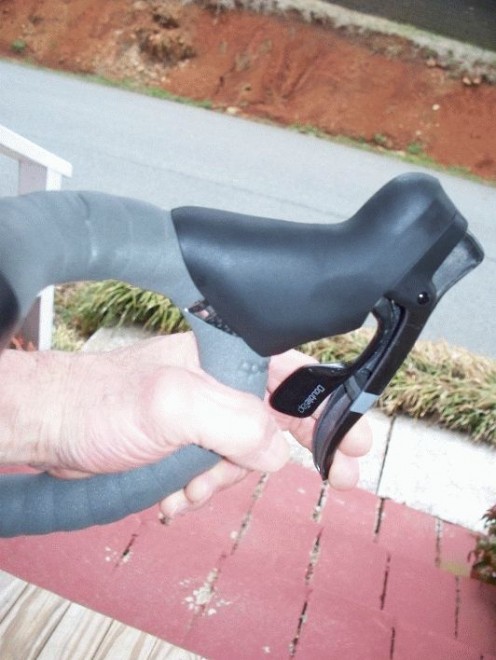
For the dangerous technical descents, stay in those “hooks”like the picture above. Levers are drawn in.
This position will allow you to-
Push your butt back off the saddle when necessary.
This is not “if” necessary. This is necessary.
If you ride downhill descents with curves, this is extremely necessary.
Now – to avoid going over the handlebars, to avoid that “endo”, push your butt back toward the rear of the saddle and it is not out of the question to push your butt off the back of that seat. Indeed. A good mountain-bike rider knows, right off, that terrain can be so steep that it’s easy to “endo”. I’ve certainly done more “endos” mountain-biking. But,the terrain changes very fast and often with mountain-biking.
Putting your butt to the rear can help lower your center of gravity.
But also, if you were to hit something in the road, you most likely will fair better with your butt back and a firm grip in the “hooks”.
There are places that seem like great places to relax. We need to gravitate toward a relaxed mindset, but while descending be ready to change your mind. Be ready to slide back and brace.
Holes in roads can be obscured and take your hands off the bars. The Blue Ridge Parkway will surprise you quite a bit.
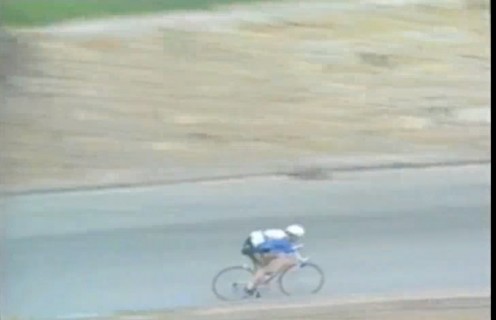
Sean Kelly, the Irishman and one of the most feared sprinters ever, wins Milan-San Remo with THE WAY TO DESCEND.
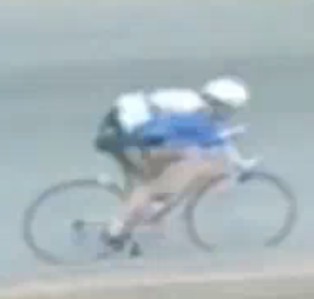
Sean Kelly in 1992 was the oldest cyclist racing professionally on "the" circuit.
You can see this brave Irishman's feat in the video below.
Kelly really begins his push and descent around the 4 minute mark.
At exactly 4 minutes and 28 seconds you will see Kelly push backward on his saddle.
1992 Milan-San Remo
Watch the video!
Notice the position of the hands.
Notice the position of Sean Kelly's body.
Notice the position of Sean Kelly's butt.
Notice the saddle protrude to the rear.
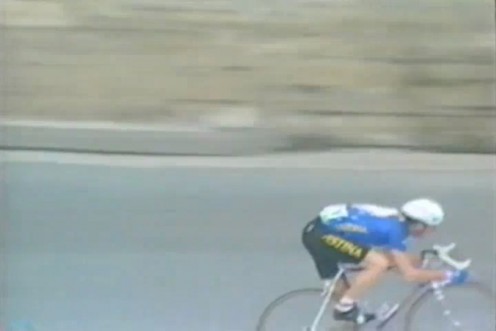
You will see, in the video, Sean Kelly slide his butt rearward.
The picture above now shows Kelly's seat is hidden.
Yes, Sean slid his body and butt back.
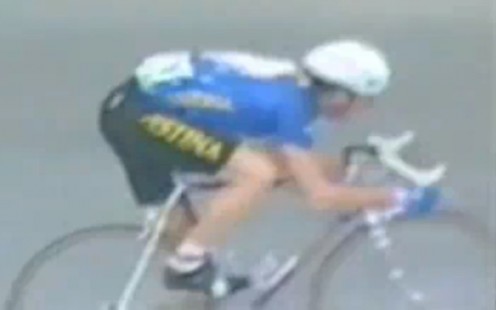
No mistake about the hands in the "hooks".
No mistake about the "disappearing saddle".
Sean Kelly did a lot of things to put himself in the position to win.
But do not deny that-
Sean Kelly won this race because he knows how to descend!
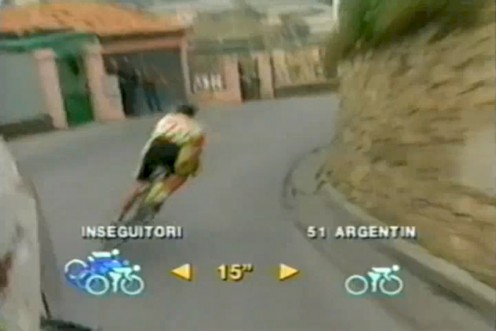
Notice Moreno Argentine.
Moreno is sitting upright.
His hands may be in their proper place, but his profile is too erect.

Moreno Argentine is one of the great all-time bicycle racers!
However:
Morino Argentine is sitting higher.
He has a higher center of gravity.
Moreno Argentine is a very accomplished racer.
He's won the world championship and so many races.
Morino plays this one wrong.
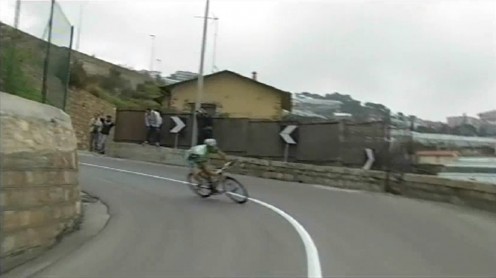
Here is another Milan-San Remo but recent.
Notice the posture.

He may have been doing several things wrong at once.
Sitting upright is certainly one of the wrong things he did.
And this neglect can attribute to the other wrong things.
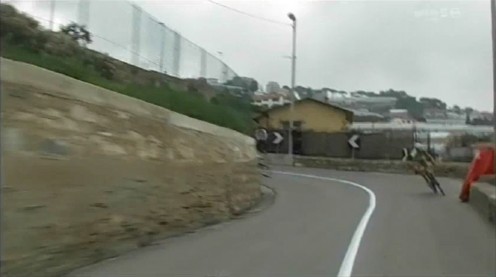
If this rider had not used his brakes IN THIS TURN, he would have hit the wall.
And some instructions say, "Brake before the curve, not in the curve."
I'm sorry. The advice of not braking in a curve is nonsense.
I see no need for this rider to go into and over that wall.

The rider is too tall in the saddle.
The higher you are,
the higher the center of gravity -
the easier it is to CRASH!
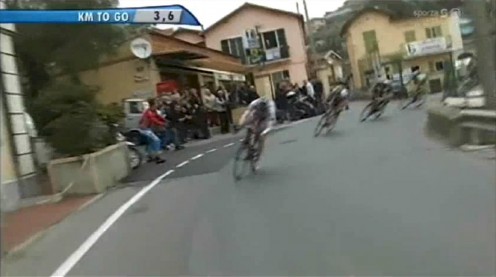
It is my opinion that all these riders are sitting too high and what has gotten them here is more speed and power than descending skills.
At 64 years of age - I would bet money I could out-descend some of these pros.
This is not a "boast".It's just what is.
I'm short, I'm ugly, I'm broke... I'm a lot of things.
But I have already out-descended pros.
And I can do it again.
Unless -
they take my advice!
Bicycle Descending Roan Mountain North Carolina
The video above is safe. I filmed this descent with a hand-held digital camera which you cannot do and go fast. The video does not contain the first 2.5 miles which are the most dangerous.
I invented the Roan Moan bike ride that is an annual event and the biggest fund raiser for the Bakersville Fire Department.
The descent was dangerous, enough so, that my friend Tony Atkins crashed and injuries including of an inner ear imbalance gave him trouble for well over a year.
I started painting "skull & cross-bones" and painted "warning" in curves all over that area.
I've done the same in places like Charleston, SC where riders have fallen over angled railroad tracks.
There are dangerous tracks, no longer used that should be taken up. Such is the case in Asheville, NC on River Road.
This is dangerous business.
When we can make things safer for others -
let's do it.
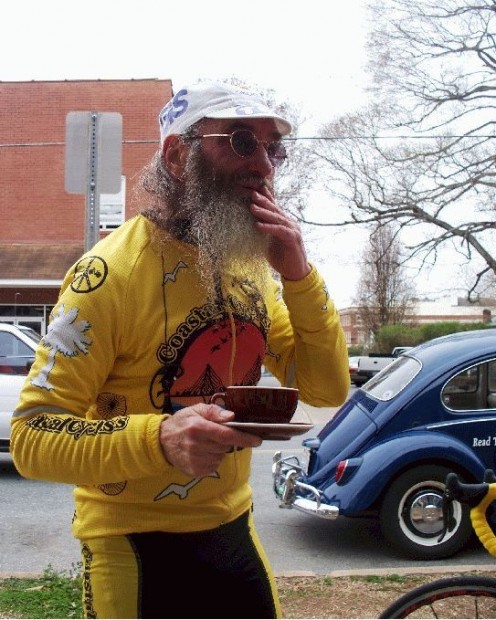
The essence of descending in the rain is,
the same as all of the above except, and this is a little tricky:
adjust brakes so that you can do all the above, plus, adjust the brakes so that the quick release is open as if you were removing the rear wheel. I like my brakes exactly like this. Otherwise a rider could stop somewhere and make that adjustment on the brakes with the adjustment barrels. The rider would have to stop in order to maintain safety while adjusting this adjusting barrel. This is assuming a person could stop.
The worst rain for skids may be the light rain. Brakes are still strong but surfaces are too slick.
Trust what I tell you: There are too many places that when there is a hard rain – your brakes can seem to completely fail.
I will give you only two examples. This is not speculation from calculations or hearsay. This is absolutely fact and I proved it and lived through it.
(1) The descents or Roan Mountain in North Carolina and Tennessee are classic examples. Roan is shared by both states.
The descent is not terribly steep but it rains so hard that you can, too easily, RUN OUT OF BRAKES. I have locked down on my brakes with a tighter grip than I would have thought possible. And still- I was gaining on a pick-up truck. I was pretty concerned. My butt cheeks had a firm grip on the seat. What I feel really “saved” me (from a spill or bumper) was that the road would straighten up enough so that the truck could speed up.
(2) Another example is a mountain of private homes near Burnsville, NC. Mountain Air is a private development where some of the temporary residents crash their airplanes occasionally. The highest elevation doesn’t really matter as you can have a steep road without the elevation. Suffice to say, it fogs over quite a bit. But it’s all a moot point because you can no longer take a “non-motorized” vehicle up to the top. I was able to ride up there years ago on my bike. A friend has a place up top. So, it’s a really hard struggle to get up there. But coming down is really tricky.
On a DRY DAY, that road is so steep, that brakes seem to fail completely. Going slowly, with my brakes as tight as I could pull, I could not come to a complete stop and I was over on the opposite side of the road. I could certainly see how a cyclist could go right off an edge and to an ugly demise upon reaching the bottom. On this mountain, a motorcycle would have an advantage because the motor could slow the machine down.
I am very sure that a cyclist, on a dry day or certainly on a wet day, went down and down.
I could tell of a terrible accident down Coxes Creek near Burnsville, NC. I could tell you of an absolute horrible accident off of Paint Paint Gap (Paint Fork Community, there are two in the same area).
For many folks, a response to downhill instruction is: “I don’t want to go downhill fast!”
There is absolutely no way to prepare for all that can happen,
including, but not limited to: deer, cows, dogs, groundhogs, and many other fauna.
I have seen oil - right down the middle of a road. Apparently a truck driver had a barrel to overturn. You cannot see it all.
My reply is, “Don’t!” Cycling is a dangerous sport.
Fast speed and curves are dangerous. Get off the bike and walk or call a cab.
There are other concepts to consider and hold dearly. Apexing is merely swinging wide and straightening out the curve in your terms. Holding your knee out and down in a curve has little to do with anything. It's used by motorcycle racing to hold some curves. It's comfortable. There should be no real focus on holding your knee out like Kenny Roberts (right-who's he?
) If you intend on dragging a knee - go ahead and plan on dragging yoour buut on the pavement too. Some "engineers will give you the angle of the dangle in which yoou might fall down and go boom. Don't find out.
But- master these techniques on this page before you master, leaning, the degrees of leaning, apexing, etc.
What I’m saying is,
“However slow, you want to go, this is still your best instruction.”
Let's be careful out there!
Happy trails,
~Micky Dee~
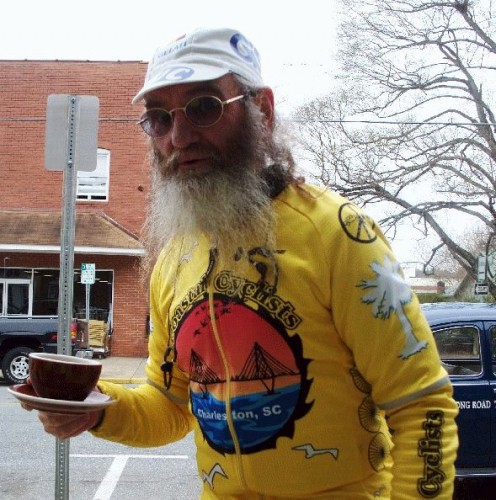
Assault On Mount Mitchell 2010-A Virtual Tour
Beginning Competitive Cycling- Keys To The Kingdom
Yearly Cycling Training Regimen
Instructions For Having A Bicycle Ride
Micky's Favorite Cycling Movies
Mick's Picks For Professional Cycling Moments On Video
Mickey's Favorite Bicycle "Descending" Videos
Major Taylor-A World Champion 1878-1932
Breaking Away From 2010 And Attacking 2011
Odes To cycling:
Friends Don't Let Friends Ride Junk!
An Ode To: The Wise Old Man - Woody Graham, Bicycle Bum
When a Cyclist’s Chamois Freezes
Don't Try A Track Stand On Three Margaritas
Breaking The Wind In A Pace-Line
TheBikingDude
- YouTube - TheBikingDude\'s Channel
Share your videos with friends, family, and the world

